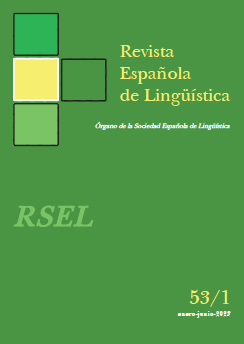the conceptualization of transgender identities in the us: a lexical, diachronic and corpus-based approach
doi: https://doi.org/10.31810/rsel.53.1.10
Keywords:
transgender linguistics; diachronic variation; corpus linguisticsAbstract
The aim of this study is to examine the conceptualization of the transgender community in the US from the mid-twentieth century until nowadays. This is achieved by analyzing the three most common terms which have been used to refer to the trans community in the timespan previously mentioned: transvestite, transsexual, and transgender. The investigation follows a corpus-based approach, gathering the data from COHA and COCA, and combines quantitative and qualitative methods to analyze the use and frequency of the words, and the semantic prosody associated to them. Similar results are obtained between the terms transvestite and transsexual both regarding their frequency distribution and usage. These terms emerged in the medical field during the 70s and the 80s, and progressively became popular in informal vocabulary. Hence, a significant semantic change is appreciated towards a more colloquial and negative meaning in which the use of the terms is sometimes conflictive, conceptualizing transgender women in derogatory and violent terms. The results regarding the term transgender are significantly different, it popularized from 2010 onward representing the transgender community a plural entity. Therefore, it is more prevalent in political, legal, mediatic and educational contexts, showing positive connotations related to the trans rights movement.
Downloads
References
Baker, P. (2017). American and British English: Divided by a common language?. Cambridge: Cambridge University Press.
Bamman, D., Eisenstein, J., y Schnoebelen, T. (2014). Gender identity and lexical variation in social media. Journal of Sociolinguistics 18(2), 135-160. doi: https://doi.org/10.1111/josl.12080
Barnett, B. S., Nesbit, A. E., y Sorrentino, R. M. (2018). The transgender bathroom debate at the intersection of politics, law, ethics, and science. The Journal of the American Academy of Psychiatry and the Law 46(2), 232-241.
Bauer, L. (2002). Inferring variation and change from public corpora, en J. K. Chambers, N. Schilling-Estes, y P. Trudgill (Eds.), The handbook of language variation and change (pp. 97-114). Oxford: Blackwell Publishing Ltd.
Blank, A. (1999). Why do new meanings occur? A cognitive typology of the motivations for lexical semantic change, en A. Blank y P. Koch, Historical semantics and cognition (pp. 61-90). Berlín: De Gruyter Mouton. doi: https://www.degruyter.com/document/doi/10.1515/9783110804195/html
Calder, J. (2020). Language, gender and sexuality in 2019: Interrogating normativities in the field. Gender and Language 14(4), 429-454. doi: https://doi.org/10.1558/genl.18634
Chambers, J. K. (2013). Patterns of variation including change, en J. K. Chambers y N. Schilling (Eds.) The handbook of language variation and change (pp. 297-323). Oxford: Wiley-Blackwell.
Cooper, H., y Shear, M. D. (2021, enero 25). Biden ends military’s transgender ban, part of broad discrimination fight. The New York Times. doi: https://www.nytimes.com/2021/01/25/us/politics/biden-military-transgender.html
Deo, A. (2015). Diachronic semantics. Annual Review of Linguistics, 1(1), 179-197. doi: https://doi.org/10.1146/annurev-linguist-030514-125100
Geeraerts, D. (1997). Diachronic prototype semantics: A contribution to historical lexicology. Oxford: Oxford University Press.
Goodwin, M., y Chemerinsky, E. (2019). The transgender military ban: Preservation of discriminarion through transformation. Northwestern University Law Review, 114(3), 751-807.
Gries, S., y Hilpert, M. (2008). The identification of stages in diachronic data: Variability-based neighbour clustering. Corpora 3(1), 59-81. doi: https://doi.org/10.3366/E1749503208000075
Hilpert, M. (2011). Diachronic collostructional analysis: How to use it and how to deal with confounding factors, en K. Allan y J. A. Robinson (Eds.), Current methods in historical semantics, (pp. 133-160). Berlín: De Gruyter Mouton. doi: https://doi.org/10.1515/9783110252903.133
Hunston, S. (2007). Semantic prosody revisited. International Journal of Corpus Linguistics, 12(2), 249-268. doi: https://doi.org/10.1075/ijcl.12.2.09hun
Konnelly, L. (2021). Nuance and normativity in trans linguistic research. Journal of Language and Sexuality 10(1), 71-82. doi: https://doi.org/10.1075/jls.00016.kon
Kulick, D. (2000). Gay and lesbian language. Annual Review of Anthropology, 29(1), 243-285. doi: https://doi.org/10.1146/annurev.anthro.29.1.243
Levin, D. (2019, julio 23). North Carolina reaches settlement on ‘Bathroom Bill’. The New York Times. doi: https://www.nytimes.com/2019/07/23/us/north-carolina-transgender-bathrooms.html
Motschenbacher, H. (2018). Corpus linguistics in language and sexuality studies: Taking stock and looking ahead. Journal of Language and Sexuality 7(2), 145-174. doi: https://doi.org/10.1075/jls.17019.mot
Motschenbacher, H., y Stegu, M. (2013). Queer linguistic approaches to discourse. Discourse and Society 24(5), 519-535. doi: https://doi.org/10.1177/0957926513486069
O’Brien, R., y Hartley, R. (1973). Sweet Transvestite [Song].
Robson Day, C., y Nicholls, K. (2021). ‘They don’t think like us’: Exploring attitudes of non-transgender students toward transgender people using discourse analysis. Journal of Homosexuality 68(6), 914-933. doi: https://doi.org/10.1080/00918369.2019.1667161
Schlechtweg, D., Hätty, A., del Tredici, M., Schulte im Walde, S. (2019). A wind of change: Detecting and evaluating lexical semantic change across times and domains. doi: http://arxiv.org/abs/1906.02979
Scorsese, M. (2002). Gangs of New York [Film].
Scott, M. (2015). WordSmith tools manual. Lexical Analysis Software Ltd.
Stewart, D. (2010). Semantic prosody: A critical evaluation. Rutledge.
Stryker, S. (2008). Transgender history, homonormativity, and disciplinarity. Radical History Review 2008(100), 145-157. doi: https://doi.org/10.1215/01636545-2007-026
Törmä, K. (2018). Collocates of trans, transgender(s) and transexual(s) in British newspapers: A corpus-assisted critical discourse analysis. doi: http://urn.kb.se/resolve?urn=urn:nbn:se:miun:diva-34339
Zhang, Q. F. (2014). Transgender representation by the people’s daily since 1949. Sexuality and Culture 18(1), 180-195. doi: https://doi.org/10.1007/s12119-013-9184-3
Zimman, L. (2020). Transgender language, transgender moment: Toward a trans linguistics, en K. Hall y R. Barrett (Eds.), The Oxford handbook of language and sexuality. Oxford: Oxford University Press. doi: https://doi.org/10.1093/oxfordhb/9780190212926.013.45
Zimman, L., y Hayworth, W. (2020). How we got here: Short-scale change in identity labels for trans, cis, and non-binary people in the 2000s. Proceedings of the Linguistic Society of America 5(1), 499. doi: https://doi.org/10.3765/plsa.v5i1.4728
Zottola, A. (2018). Transgender identity labels in the British press: A corpus-based discourse analysis. Journal of Language and Sexuality 7(2), 237-262. doi: https://doi.org/10.1075/jls.17017.zot
Published
How to Cite
Issue
Section
Copyright (c) 2023 Revista Española de Lingüística

This work is licensed under a Creative Commons Attribution-NonCommercial-NoDerivatives 4.0 International License.











